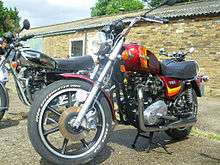Triumph T140 TSX
|
| |
| Manufacturer | Triumph Engineering |
|---|---|
| Production | 1982–1983 |
| Engine | 748 cc (45.6 cu in) air cooled four stroke, parallel twin, two valves per cylinder |
| Power | 48.6 hp (36.2 kW) @ 6,500 rpm |
| Transmission | 5-speed to chain final drive |
| Fuel capacity | 10.5 litres (2.3 imp gal; 2.8 US gal) |
The Triumph TSX was a British motorcycle credited by the factory as being designed in 1981–1982 by Triumph Motorcycles America (TMA), the factory's American arm. Steve Wilson's British Motorcycles Since 1950 and Lindsay Brooke and David Gaylin's Triumph Motorcycles In America specifically credit Wayne Moulton, TMA's president, as the designer as he was responsible for the earlier, successful and similarly styled 'LTD' series of motorcycles for his previous employers, Kawasaki. But factory correspondence shows Brenda Price, Moulton's predecessor, had earlier persuaded Brian Jones, Meriden's engineering director, to come up with a low rider-styled Triumph for the USA market, her having observed their US dealers' success at independently marketing such models. John Barclay of the factory had earlier designed a prototype low rider, the Phoenix, exhibited on the factory stand at the 1980 London Earls Court motorcycle show. This model with its rectangular headlamp and unusual instrument console was not produced.
Specification
Essentially a re-styled Triumph Bonneville, the "West Coast" styled TSX was distinguished by its lowered chassis and 16-inch-diameter (410 mm) rear wheel with the engine off-set in the frame to accommodate this. Other changes, whilst unique to the model, were cosmetic including stepped seat, black finished engine with polished fins, re-styled passenger grabrail, shortened front and rear painted mudguards, the latter having a black plastic extension for the larger UK vehicle numberplate, chromed shorty megaphone exhausts with the crossover pipe hidden between them under the bike and flowing thru 1.75" pipes, Morris alloy wheels (then made by Performance Machine) and 'retro' stick on graphics outlined in the usual gold hand pinstriping. Paioli rear suspension units, with plastic top shrouds, were sited at a more acute angle further back on the swinging arm to lower the seat height. A slightly lower rise and wider USA style handlebar was fitted and chromed Lucas turn indicators returned in place of the black plastic ULO items that had replaced them on other Triumph models from 1981. A chromed wire mounted Lucas headlamp with sealed beam was changed to the Lucas H4 early in the production run. A Brembo rear brake master cylinder was fitted in place of the usual Automotive Products (AP) Lockheed item which remained for the front, as well as supplying both calipers. Dual front discs were an option. Whilst the 1982–1983 brochure showed Goodyear Eagle tyres fitted, an Avon Roadrunner rear and Speedmaster front tyre went on production models, the tyres' lettering picked out in white. Although the German magazine Motorad road-tested a kick start-only version, the kickstart was an optional extra on the production TSX. The standard TSX engine was a T140ES (electric start) 748 cc (45.6 cu in) with two 32-mm Bing carburettors and electronic ignition. The engine was offset to accommodate the fatter rear tyre within the frame which also necessitated a unique swingarm and abbreviated chromed chainguard. The engine also benefitted from an updated crank with more careful machining; the result being greatly reduced vibration. The TSX fuel tank was a unique design for the model having only one Paioli left hand petrol tap situated ahead to accommodate the larger Bing carburettors. This tank also had a centralised filler hole with optional locking cap and a balance pipe situated on the front of the tank's underside.

Production
According to Triumph's records held by the Vintage Motor Cycle Club (VMCC), the first TSX was made for the North American market on 18 June 1981.
A total of 371 were produced with 200 shipped to the USA, 100 remaining in the UK and 71 to the rest of the world. Of these 371 units, approximately two-thirds were Gypsy Red in color, and the remaining one-third were Midnight Black. The factory, upon request, produced TSX with a pre-1975 right foot gear change/left foot rear brake assembly and an example of this can be seen at the London Motorcycle Museum.
From the records as held by the VMCC, the last TSX was made on 21 December 1982.
Epilogue
From Triumph's brochures, the TSX, unchanged, was to have been included in the factory's unrealised 1984 range as the TSX4 with a similarly styled TSX8 with the eight valve engine from the Triumph T140W TSS alongside. Side panel badges added a '4' or '8' to reflect the new designations. Wayne Moulton who designed the TSX, had originally done so with the 8-valve TSS engine in mind.
Nearly all of the TSX cycle parts were used to re-style the 1984 prototype USA versions of the T140 Bonneville and the new TR6 Thunderbird 600, both models only distinguished from the TSX4 by instead retaining wire wheels and adopting the drum rear brake from the deleted Triumph TR65 Thunderbird and TR7T Tiger Trail models. Although not fitted to the 1982–1983 production models, Dunlop tyres, of their 'Qualifier' design this time, were again shown on all USA -styled brochure models, the tyres' lettering again picked out in white. The TSX4 and TSX8 both retained the Avon tyres, fore and aft, as before. The TSX rear mudguard, albeit finished in stainless steel finish, and retaining the plastic UK numberplate mounting extension, was also to have been fitted on all UK–Rest Of World models as standard.
Production ceased with the closure of the Meriden works in August, 1983.